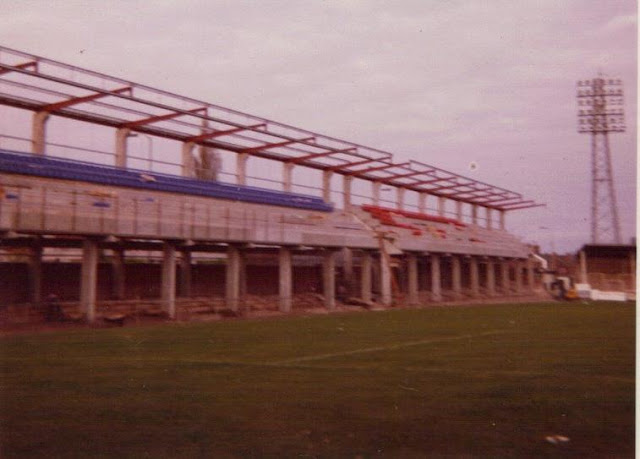This from Save Edgar Street Blog:
 |
| Building The Len Weston Stand |
The Len Weston stand is one of the earliest examples of a cantilever stand in the United Kingdom that still exists. It is 350 feet long and 15 feet wide. The width being dictated by the size of the pitch and the perimeter of the ground. The need for a new stand had begun five years earlier. In 1968 a new ring road was built along Edgar Street. The road widened thus creating the need for a slimline stand to replace ‘The Ark’ which had been inherited from Luctonians Rugby Club.
Planning for the new stand began in 1970 as part of United’s campaign for football league status. Local building contractor Harry Vaughan took on the project in full knowledge that the club had not yet raised the money to pay for the work. Herefordshire firm ‘Building Services’ were responsible for the sheeting and cladding and the grandstand structure was supplied and erected by ‘Concrete (Midlands) Limited’ of Lichfield. It comprised a precast concrete column and beam frame, supporting precast concrete stepped terracing units. These units supported successive steps with an interlocking action. Fixings were cast into the step units to which seats were later attached.
 |
The stand was named In honour of club stalwart and benefactor Len Weston who had contributed his time, skills and money to the club during the 1950s and 60s. The 1,200 capacity stand opened on 6 January 1973 when the Bulls beat Bradford City courtesy of a Kenny Wallace goal.
The application for Grade II listing is an important step to #SaveEdgarStreet and preserve a small piece of football heritage. The first cantaliver stand is widely recognised to have been built at Scarborough’s ‘Old Show Ground’ but this has long since been demolished following the clubs relocation in 1988. Listing is important to ensure that a small number of these stands continue to exist so that our heritage can be preserved.
Some may well believe that the listing will only cause difficulties for the club moving forward but that doesn’t need to be the case. So long as work is undertaken to maintain and look after the stand then it should be suitable to survive for many years to come. Over time it will become an attraction to visitors to the City and become a welcome asset of the club.
The listing need not prevent a future relocation. The redevelopment of Arsenals former home, Highbury, skilfully created a new development whilst preserving the important historical elements of the stadium for future generations. Therefore it is important that this application for listing is seen as an opportunity rather than a barrier. An opportunity to save a unique example of architectural and footballing heritage. An opportunity to #SaveEdgarStreet.

.png)